Developing regulation of energy efficiency of private sector housing (REEPS): modelling improvements to the target stock - Main Research Report
This report describes how the least energy efficient dwellings in the private sector were identified and how their ratings could be improved by a range of improvement measures. Modelling was used to ascertain the least cost way of reaching different standards, with findings presented on capital costs, fuel cost savings, carbon and energy reductions.
16 Appendix 10: Turnover Rates In The Owner Occupied And Private Rented Sector
16.1 The following appendix was produced by Oscar Guinea and Adam Krawczyk at the Scottish Government to help estimate turnover rates among the target stock.
Length of tenure
16.2 The Scottish House Condition Survey (SHCS) asks respondents for the number of years they have been living in the property. SHCS data for 2011-2013 (three years) was used to calculate the length of tenure in the owner occupied sector (OO) and the private rented sector (PRS) by EPC band.
16.3 The advantages of using SHCS data are:
- Methodological consistency across OO and PRS
- Possibility to break down the results by EPC band.
- Possibility to produce the results by individual years to estimate a profile of sales within a period of time.
Figure A10.1: Length of tenure in the OO by EPC band and year
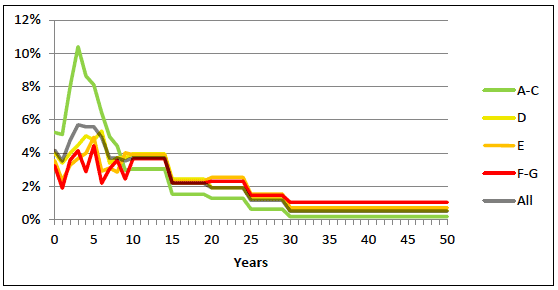
16.4 For households staying in their properties for more than 10 years, SHCS data is produced in 5-year bands while the last category is more than 30-year. We have adjusted this dividing the 5-year bands by 5 while the more than 30-year category was divided by 20 to produce a 50 years period. The original data on the length of tenure by EPC is presented in Tables 10.2 to 10.5.
16.5 For the OO sector, it needs to be noted that 21% of properties with an EPC of F and G and 14% of properties with an EPC of E have a length of tenure of more than 30 years. This might be relevant for specifying an backstop date.
16.6 The same approach is applied for the PRS. It is worth highlighting the high turnover rate in the private rented sector with 40% of E and 33% of F and G properties with a turnover of less than year. The fast turnover rate means that 88% of properties with an EPC of E and 77% of properties with an EPC of F and G will be on the market for rent and therefore will be subjected to REEPS before 10 years.
Figure A10.2: Length of tenure in the PRS by EPC band and year
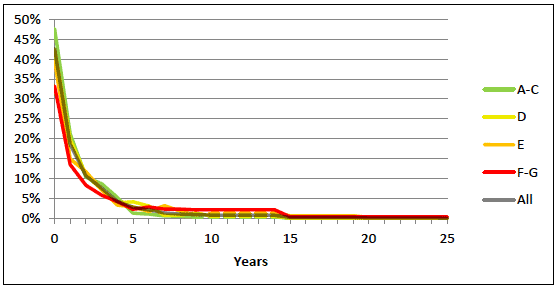
16.7 Length of tenure as a proxy for turnover can be used to calculate the rate at which properties in the OO and PRS are impacted by REEPS. For example the SHCS show us that in the first year of REEPS 4% of EPC E properties in the OO and 40% in the PRS will be sold or rented, and depending on the secenario, will need to be upgraded.
16.8 In the second phase of the REEPS study, Ipsos MORI and Alembic Research produced a breakdown of properties in the private sector by EPC band.
Table A10.1: Breakdown of EPC bands among private sector stock in bands EFG.
| Percentage of dwellings | Dwellings | OO | PRS | |||
|---|---|---|---|---|---|---|
| dwellings | % | dwellings | % | |||
| EPC band E (39-54) | 57.4% | 229,840 | 194,158 | 60% | 35,682 | 46% |
| EPC band F (21-38) | 35.2% | 141,032 | 110,904 | 34% | 30,128 | 39% |
| EPC band G (0-20) | 7.4% | 29,676 | 17,776 | 6% | 11,900 | 15% |
| All | 100% | 400,548 | 322,838 | 100% | 77,710 | 100% |
16.9 Applying length of tenure to the figures in Table A10.1 produces a profile of the number of properties that will be upgraded as a result of REEPS. These results are contained in tables A10.2 to A10.5. The following graphs show the cumulative number of properties impacted by REEPS per year for the first three scenarios as specified in REEPS. The boxes below higlight from which year the cumulative number of properties reaches 50% and 75% of all properties which are subjected to REEPS under each scenario.
Figure A10.3: Scenario 1: All dwellings to reach Band F
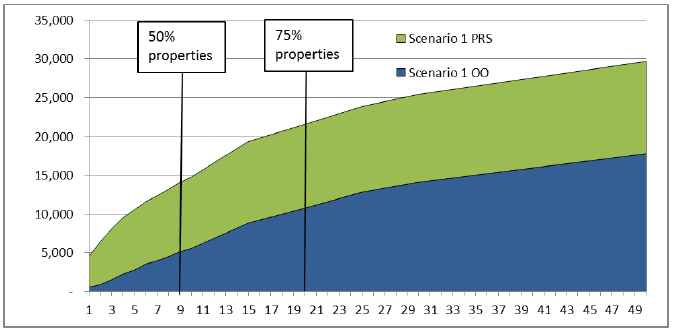
Figure A10.4: Scenario 1: All dwellings to reach Band E
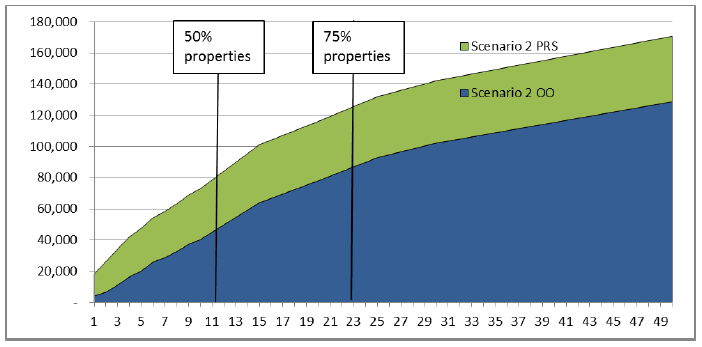
Figure A10.5: Scenario 1: All dwellings to reach Band D
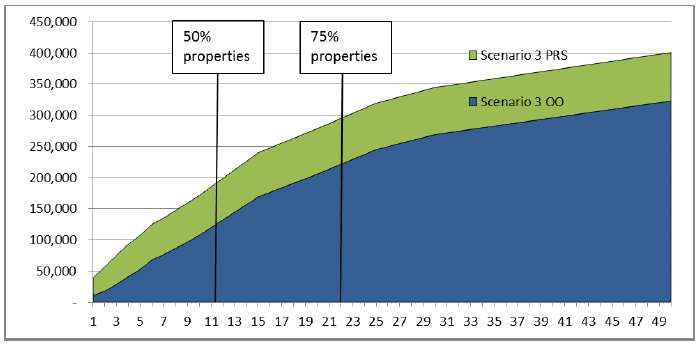
Table A10.2: Owner-occupied: Proportion length of stay by EPC band
| A-C | D | E | F-G | All | |
|---|---|---|---|---|---|
| <1year | 5% | 4% | 4% | 3% | 4% |
| 1<2 years | 5% | 3% | 2% | 2% | 4% |
| 2<3 years | 8% | 4% | 3% | 4% | 5% |
| 3<4 years | 10% | 4% | 4% | 4% | 6% |
| 4<5 years | 9% | 5% | 4% | 3% | 6% |
| 5<6 years | 8% | 5% | 5% | 4% | 6% |
| 6<7 years | 6% | 5% | 3% | 2% | 5% |
| 7<8 years | 5% | 3% | 3% | 3% | 4% |
| 8<9 years | 4% | 4% | 3% | 4% | 4% |
| 9<10 years | 3% | 4% | 4% | 2% | 4% |
| 10<15 years | 15% | 20% | 20% | 18% | 19% |
| 15<20 years | 8% | 12% | 12% | 11% | 11% |
| 20<25 years | 6% | 10% | 13% | 11% | 10% |
| 25<30 years | 3% | 6% | 8% | 7% | 6% |
| 30+ years | 3% | 11% | 14% | 21% | 10% |
Table A10.3: Owner-occupied: Cumulative length of stay by EPC band
|
|
A-C |
D |
E |
F-G |
All |
|---|---|---|---|---|---|
| <1year |
5% |
4% |
4% |
3% |
4% |
| 1<2 years |
10% |
7% |
6% |
5% |
8% |
| 2<3 years |
18% |
11% |
9% |
9% |
12% |
| 3<4 years |
29% |
16% |
13% |
13% |
18% |
| 4<5 years |
37% |
21% |
17% |
16% |
24% |
| 5<6 years |
46% |
26% |
22% |
20% |
29% |
| 6<7 years |
52% |
31% |
25% |
22% |
34% |
| 7<8 years |
57% |
34% |
28% |
25% |
38% |
| 8<9 years |
61% |
38% |
31% |
29% |
42% |
| 9<10 years |
64% |
42% |
35% |
31% |
45% |
| 10<15 years |
80% |
62% |
54% |
50% |
64% |
| 15<20 years |
87% |
74% |
66% |
61% |
75% |
| 20<25 years |
94% |
83% |
78% |
72% |
84% |
| 25<30 years |
97% |
89% |
86% |
79% |
90% |
| 30+ years |
100% |
100% |
100% |
100% |
100% |
Table A10.4: Private Rented Sector: Proportion length of stay by EPC band
|
|
A-C |
D |
E |
F-G |
All |
|---|---|---|---|---|---|
| <1year |
48% |
42% |
40% |
33% |
43% |
| 1<2 years |
21% |
20% |
15% |
14% |
19% |
| 2<3 years |
10% |
11% |
12% |
8% |
11% |
| 3<4 years |
9% |
7% |
7% |
6% |
8% |
| 4<5 years |
5% |
4% |
3% |
4% |
4% |
| 5<6 years |
1% |
4% |
3% |
2% |
3% |
| 6<7 years |
1% |
3% |
2% |
3% |
2% |
| 7<8 years |
1% |
1% |
3% |
2% |
1% |
| 8<9 years |
1% |
1% |
2% |
2% |
1% |
| 9<10 years |
0% |
1% |
1% |
2% |
1% |
| 10<15 years |
2% |
3% |
6% |
11% |
4% |
| 15<20 years |
0% |
1% |
3% |
2% |
1% |
| 20<25 years |
0% |
1% |
1% |
2% |
1% |
| 25<30 years |
0% |
0% |
0% |
2% |
0% |
| 30+ years |
0% |
1% |
1% |
5% |
1% |
Table A10.5: Private Rented Sector: Cumulative length of stay by EPC band
|
|
A-C |
D |
E |
F-G |
All |
|---|---|---|---|---|---|
| <1year |
48% |
42% |
40% |
33% |
43% |
| 1<2 years |
69% |
62% |
55% |
47% |
61% |
| 2<3 years |
79% |
73% |
66% |
55% |
72% |
| 3<4 years |
88% |
80% |
74% |
61% |
80% |
| 4<5 years |
93% |
84% |
77% |
65% |
84% |
| 5<6 years |
95% |
89% |
80% |
68% |
87% |
| 6<7 years |
96% |
92% |
82% |
71% |
89% |
| 7<8 years |
96% |
93% |
85% |
73% |
90% |
| 8<9 years |
97% |
93% |
87% |
75% |
91% |
| 9<10 years |
97% |
95% |
88% |
77% |
92% |
| 10<15 years |
100% |
98% |
94% |
88% |
97% |
| 15<20 years |
100% |
98% |
98% |
91% |
98% |
| 20<25 years |
100% |
99% |
99% |
93% |
99% |
| 25<30 years |
100% |
99% |
99% |
95% |
99% |
| 30+ years |
100% |
100% |
100% |
100% |
100% |
Contact
Email: Silvia Palombi
There is a problem
Thanks for your feedback